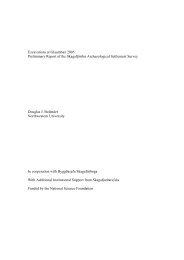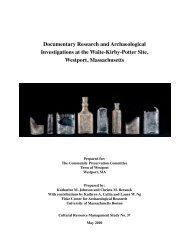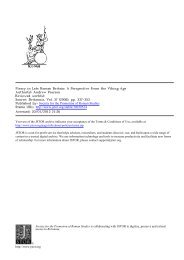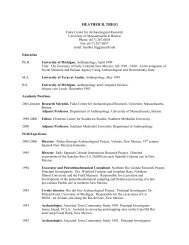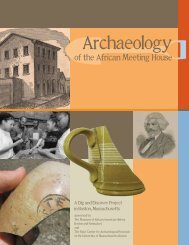Barrett, Locker and Roberts - Fiske Center
Barrett, Locker and Roberts - Fiske Center
Barrett, Locker and Roberts - Fiske Center
Create successful ePaper yourself
Turn your PDF publications into a flip-book with our unique Google optimized e-Paper software.
James H. <strong>Barrett</strong>, Alison M. <strong>Locker</strong> & Callutn M. <strong>Roberts</strong><br />
(hitliLTiitTstik<br />
i<br />
^v<br />
1 1 '<br />
Dale<br />
Daio<br />
OulllFI 1:11 Hair<br />
O<br />
d)<br />
.<br />
1 q 1<br />
Date<br />
Figure 4. Boxplots showing imreilses in the hiienncy oj fishing, afifi the importance of cod <strong>and</strong> reLited species, in northern<br />
ScotLind during both the ninth/tenth <strong>and</strong> eleventh/twelfth centuries AD. The preceding 'Pictish'period covers approximately<br />
the fourth to eighth centuries, (a) The number offish bones recovered, (b) The ratio offish bone to mammal hone, (c) The ratio<br />
of inshore to offshore taxa - based on a comparison of ling (Molva molvaj <strong>and</strong> Torsk (Brosme brosmej to rocklings (Ciiiata or<br />
Gaidropsarus species), wrasse (Labridae) <strong>and</strong>cottids (Cottidiie). (d) The ratio of cod family to all otherfnh. The data are based<br />
on NISP figures <strong>and</strong> have been taken from <strong>Barrett</strong> <strong>and</strong> 0/tmann (1998): <strong>Barrett</strong> et al. (1999: 2001) <strong>and</strong> references therein.<br />
Date<br />
fishery may have existed by 1086 ba^ed on chc record of fishermen at Great Yarmouth in<br />
Domesday Book (Taylor 1988:466), but earher evidence is anecdotal at best (e.g. Gushing<br />
1988:79-80). It is a rcasonabiehypothesis that the increasing catch of herring <strong>and</strong> cod around<br />
AD 1000 was concurrent with the early development of this pan-European fish trade —<br />
which then took approximately a century to enter the historical record.<br />
In support of this suggestion, it is clear that marine species were increasingly abundant at<br />
both coastal (or estuarine) settlements, where local catches were possible, <strong>and</strong> inl<strong>and</strong> sites<br />
(such as York, Northampton <strong>and</strong> Eynsham Abbey), where an element of trade can be assumed<br />
(Figures 5-6). Butchery evidence is not consistently available to assess how the fish were<br />
processed (cf. <strong>Barrett</strong> 1997; Enghoff 1996; <strong>Locker</strong> 2001), but some of them must have been<br />
cured for inl<strong>and</strong> transport <strong>and</strong> storage. Many of the fish bones from coastal <strong>and</strong> estuarine<br />
settlements (such as London, on the tidal Thames) may also represent preserved fish acquired<br />
by trade, but this is more dii^ficult to prove.<br />
Given the chronology of the zooarchaeological evidence, it may not be coincidental that<br />
two of the earliest explicit Anglo-Saxon references to fish trade also date to the end of the<br />
625



